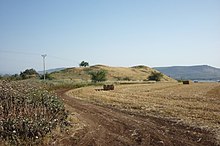Kinneret (city)
Kinneret (Arabic: Tell el-Oreme ) is a city named in the Bible at the northwest end of the Sea of Galilee in Israel. This city gave the lake its Hebrew name (Hebrew: ים כנרת, Jam Kinneret). The Kibbutz Ginnossar , now south of the tell , also derives its name as a Hellenized form of Kinneret. Kinneret was a main town in the settlement area of the Naftali tribe .
Since Kinneret was previously believed to be on the south bank of the lake near Chirbet el-Kerak, an agricultural settlement and a kibbutz, both founded there around 1910, bear the biblical name Kinneret. At Chirbet el-Kerak, however, there were no surface finds from the Iron Age II. The identification of Kinneret with Tell el-Oreme finally succeeded Gustaf Dalman and William F. Albright independently of one another in 1922. The property has been owned by the German Association of the Holy since 1886 Land , whose pilgrim house Tabgha is on the eastern slope of the valley. Today there is a pumping station on the southern slope of the hill, from which water is transported from the Sea of Galilee via the Israeli National Water Carrier to the Negev desert.

Under the direction of Volkmar Fritz , the Akropolis was archaeologically examined from 1982–1985 and the side of the Tell sloping down to the lake from 1994–1999. Employees during the first phase included Ulrich Hübner , Klaus Koenen , Jürgen Zangenberg and Wolfgang Zwickel , and during the second phase Gunnar Lehmann , Dieter Vieweger and Thomas Wozniak, among others .
Written sources
- List of Thutmose III. , around 1468 BC Chr.
- Papyrus Leningradensis 1116A (List of Canaanite Cities)
- Joshua 19:35 (List of Places of the Naftali Tribe )
Archaeological evidence
Early Bronze Age I and II
From this earliest settlement phase, little remained due to the settlement activities in later times. It is not clear whether the settlement was fortified; in any case, the Tell was from about 2700 BC. Uninhabited for centuries. (During this gap, the nearby town of Hirbet el-Kerak flourished.)
Middle Bronze Age II C to Late Bronze Age
Around 1550 BC A city fortified with a mud brick wall was rebuilt on the Tell, at the foot of the examined slope. This is the city of Kinneret known from Egyptian sources. The settlement interruption occurred again in the Late Bronze Age.
Iron Age I.
The Iron Age city was rebuilt on an embankment above the Late Bronze Age city. “The city was planned extremely carefully ... The streets run parallel to the slope with an incline of about 25 degrees and intersect with the streets leading down the slope at right angles. The resulting insulae were built on with residential houses, some of which are of the courtyard house type. ”This Kinneret was the central location of the entire region, with a city wall that was sometimes over 12 m wide. The fact that layer V is particularly rich could be the result of sudden destruction by an earthquake (or a conquest).
The Kinneret of the Early Iron Age probably belonged to the Aramaic principality of Geschur , a regional power to which David (according to 2 Samuel 3: 3) was on friendly terms. The end of this settlement phase could be related to the rise of the Aramaic empires east of the Sea of Galilee.
Iron Age II
Around 800 BC A fortress was built on Tell; this building activity can be related to Joasch's policy against the Arameans (2 Kings 13, 25). Soon afterwards, a typical Israelite city (gate square, pillar houses, residential buildings) was founded on Tell - this is probably what is meant in the list Joshua 19:35. Here a 10 cm tall bronze figure of the seated deity El was found .
Although Kinneret is not mentioned in 2 Kings 15:29, because of its strategically favorable location, it must be assumed that Tiglat-Pileser III. the city in 734/733 BC Chr. Conquered and destroyed. Traces of the conquest are visible in the gate area. After that the place was given up and not settled again in antiquity, apart from a Ptolemaic homestead and some Byzantine shards.
literature
- Volkmar Fritz: Tell el-Oreme / Kinneret. In: Jürgen Zangenberg et al. (Ed.): Life on Lake Gennesaret. Cultural and historical discoveries in a biblical region. Philipp von Zabern, Mainz 2003, ISBN 3-8053-2914-8 , pp. 33-42.
- Walter Dietrich, Stefan Münger: Center and Periphery - The early Iron Age city of Kinneret and its regional context. In: Jürgen Zangenberg et al. (Ed.): Life on Lake Gennesaret. Pp. 43-46.
Individual evidence
- ^ Volkmar Fritz: Tell el-Oreme . S. 33 .
- ^ Volkmar Fritz: Tell el-Oreme . S. 36 .
- ^ Volkmar Fritz: Tell el-Oreme . S. 37 .
- ↑ a b c Volkmar Fritz: Tell el-Oreme . S. 39 .
- ^ Walter Dietrich, Stefan Münger: Center and periphery . S. 44-45 .
- ^ Volkmar Fritz: Tell el-Oreme . S. 40 .
- ^ Volkmar Fritz: Tell el-Oreme . S. 41 .

